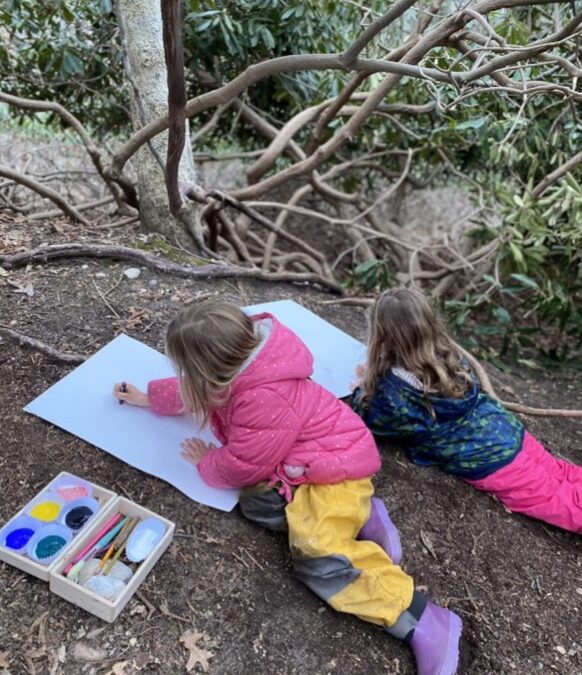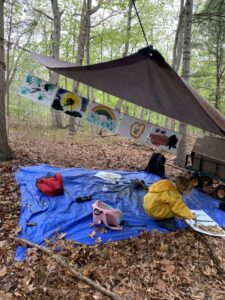Beyond Picture Perfect: How To Celebrate Child-Led Art

“Art is Not a Receipt for Child Care”: Lisa Murphy, M. Ed.
You won’t find perfectly crafted product-based art pieces at Aishling Forest School, as we believe in the power of process-based, child-led art and nature as a creative conduit for lifelong learning. As Lisa Murphy, M.Ed. and early childhood specialist states, product art is neither play-based nor child-directed; in fact, these projects are planned by adults and often children are persuaded—even forced—to stop what they are doing to participate. “It violates everything we know about choice, and attention, and play, and whose needs are being met.”
That’s why playing with art materials in nature is so important. There is something wildly creative and unique about creating process-based art in nature and we are delighted in how our Artists in the Forest program is blossoming this season, as well as our many process-based art sessions in our Forest School Essentials program. The best description for the magical union of art and nature is worded by one of our favorites, Henry David Thoreau, “It is the marriage of the soul with nature that makes the intellect fruitful, and gives birth to imagination.” Spending this sacred time in the forest creating art with our learners has encouraged their personal expansions in numerous ways, such as an increase in their fine motor skills, imagination, and overall appreciation for art and nature.
 Throughout this 2021 spring season, we have explored many artistic skills and media that have helped our learners expand inside and out. Not only have we played with the classics such as painting and drawing, but we have also delved into weaving and wrapping using natural materials. Over the last two weeks, our learners have discovered (at their own pace and in their own unique ways) how to cut, wrap and tie knots with yarn to create wands. We then scaffolded the learning in finding branches to create miniature looms with yarn. Next, we’ll be offering up wire wrapping natural materials to invite the learners to design and create their own nature jewelry. All of these fine motor skills of wrapping, looping, tying, and knotting have been exponential exercises in coordination, grip strength, pincer grip and general handiwork skill development.
Throughout this 2021 spring season, we have explored many artistic skills and media that have helped our learners expand inside and out. Not only have we played with the classics such as painting and drawing, but we have also delved into weaving and wrapping using natural materials. Over the last two weeks, our learners have discovered (at their own pace and in their own unique ways) how to cut, wrap and tie knots with yarn to create wands. We then scaffolded the learning in finding branches to create miniature looms with yarn. Next, we’ll be offering up wire wrapping natural materials to invite the learners to design and create their own nature jewelry. All of these fine motor skills of wrapping, looping, tying, and knotting have been exponential exercises in coordination, grip strength, pincer grip and general handiwork skill development.
A large portion of the projects we’ve investigated this season are designed to encourage creative thinking and imagination. And that’s what process-based art is all about, the process NOT the product. In her book, Preschool Art: It’s the Process not the Product, Mary Ann Kohn wrote, “Young children ‘do’ art for the experience, the exploration, the experimentation. In the ‘process’ they discover mystery, creativity, joy, and frustration. The resulting masterpiece, whether it be a sticky glob or meritorious gallery piece, is only a result to the young child, not the reason for doing art in the first place.” And while process-based art may not look cute on the refrigerator, the results of the process are much more important: creativity, problem solving, collaboration, independence, language development, and social skills—the kind of things that simply cannot be gained by creating the perfect letter D for dinosaur.
One of our first projects at Artists in the Forest was exploring, identifying, sourcing, and inviting the learners to create an art toolbox from natural materials found in the forest. The learners used magnifying glasses to explore the forest floor, looking for the perfect elements to mash with water to create their own natural pigments to then spread, mush, dab onto their art box. Subsequently, our little artists spent the next few classes searching for hollowed twigs, fur, or pine needles to create their own paintbrushes. Many of the learners excitedly still add to their art box as we enter the forest at the beginning of each class.
As we effortlessly become deeply inspired by our surroundings when exploring for these materials, we watch as the learners simply fall in love with nature and develop a deep sense of appreciation and awe for the greater world around them. Every few classes we encourage our learners to make a “sit spot painting”. A sit spot is simply a favorite place in nature that you visit regularly to cultivate awareness as you expand your senses and study patterns of local plants, birds, trees, or animals. Our learners pick their spot and we equip them with the art materials that they desire to work with and then nature does the rest. In “The Connection Between Art, Healing, and Public Health”, Heather L. Stuckey, DEd and Jeremy Nobel, MD, MPH have concluded that, “There is evidence that engagement with artistic activities, either as an observer of the creative efforts of others or as an initiator of one’s own creative efforts, can enhance one’s moods, emotions, and other psychological states as well as have a salient impact on important physiological parameters”. Learners who may have had trouble focusing on a group project seem to fall into a deep trance of working meticulously on a neverending painting that they love, in a space that they love equally as much.
develop a deep sense of appreciation and awe for the greater world around them. Every few classes we encourage our learners to make a “sit spot painting”. A sit spot is simply a favorite place in nature that you visit regularly to cultivate awareness as you expand your senses and study patterns of local plants, birds, trees, or animals. Our learners pick their spot and we equip them with the art materials that they desire to work with and then nature does the rest. In “The Connection Between Art, Healing, and Public Health”, Heather L. Stuckey, DEd and Jeremy Nobel, MD, MPH have concluded that, “There is evidence that engagement with artistic activities, either as an observer of the creative efforts of others or as an initiator of one’s own creative efforts, can enhance one’s moods, emotions, and other psychological states as well as have a salient impact on important physiological parameters”. Learners who may have had trouble focusing on a group project seem to fall into a deep trance of working meticulously on a neverending painting that they love, in a space that they love equally as much.
Artists in the Forest is a place where we hold a safe space for our children to explore their imaginations in the beautiful comfort of the arms of Mother Nature. Many child psychologists will use art therapy to help young learners work through communicating difficult feelings and thoughts, as for them it is much easier to express with images and symbols than it is with words. Art is also a form of early literacy, as scribbles will soon become words. It is an honor to hold that space for our learners to express any and all feelings through their beautiful artwork, knowing that Mother Nature holds that safe home for them and always will for the rest of their lives.
Here are some nature-inspired ways to support process-based art at home:
- Take your art supplies outside and take a step back. That’s the best way to start.
- Talk with your child about their work. It’s often hard to decipher a child’s drawings, even though the child knows exactly what it is. When we ask, “What is it?” we are saying that it should look like something we’d recognize. Instead, ask open-ended questions like “Tell me about your picture.” You can also describe specific things your child is doing by saying things such as, “You’re making short lines, I see you are using red, green and blue.”
- Imitate your child. Instead of drawing your own picture, sit down with your child and imitate their actions. Make big scribbles, small lines or practice drawing circles. If your child is focused on what you are drawing or how “good” your picture is, they are less likely to be imaginative and creative on their own.

- Provide choices. Gather a wide range of materials for your child to use like paint, colored pencils, chalk, play dough, markers, crayons, oil pastels, scissors and stamps. Supplement with natural materials, as well- like acorns, leaves, flowers, pine cones and other items they can use for natural pigments. Mud is always awesome!
- Support, don’t lead. Have you ever noticed that activities become much less fun when they are dictated by someone else? The same goes for kids—let them decide what materials they want to use and how and when to use them.
- Keep it open-ended. Instead of sitting down with a specific plan or outcome in mind, let your child explore, experiment and use their imaginations. They might make a big mess (yet another reason why being outside is awesome!) or change their mind several times—this is all part of the creative process. A good rule of thumb: if it takes you longer to set up and give instructions than for your littles to create the art, it isn’t process-based art.
- Focus on the process, not the product. Encouraging your child in the action of unstructured art helps them work with intrinsic motivation. It teaches them to express themselves freely, without worrying about what others think. If a lot of attention is given to the final product or we spend a lot of energy praising the end result, a child may be more likely to do things to get your approval instead of doing what they want to do. Notice their hard work!
- Let it go. As long as a child is safe as necessary (not as possible), let them explore freely. They may spend the majority of the time sharpening colored pencil or touching pine cones instead of actually drawing or painting with them. Children learn through playing, exploring and trial and error. When we give them freedom to discover, they are learning to create and experiment in new and innovative ways.
Storytelling + Storyacting: A Powerful Tool For Children
“Storytelling is the most powerful way to put ideas into the world today.”- Robert McAfee Brown So some may wonder, why is storytelling so crucial to children’s development and how can we encourage the practice with them? “Storytelling connects your child to...
What is Friluftsliv and Can It Make Us Healthier, Happier and More Creative?
"Friluftsliv isn't something you can touch. It's something you feel in your soul."– August Casson Friluftsliv (pronounced FREE-loofts-liv) or “open-air life” is a big part of Aishling Forest School’s outdoor pedagogy and is a centuries-old Nordic tradition of...
How Forest School Nurtures Brain Development
“When we help a child to feel secure, feel appreciated, feel that “somebody is deeply, truly interested in me,” by the way we just look, the way we just listen, we influence that child’s whole personality, the way that child sees life.” – Magda Gerber It is...





